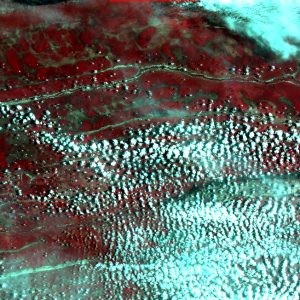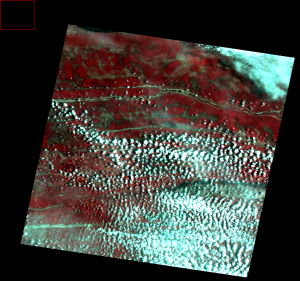![]() =>
=> ![]() The « orthorectification » is a geometrical correction of images that aims at presenting them as if they had been captured from the vertical (in the remote sensing community, we say from « Nadir »), In practice, it transforms the satellite picture in an image that can be regiistered on a map. To do that, the raw (L1A) product provides us with a lot of information
The « orthorectification » is a geometrical correction of images that aims at presenting them as if they had been captured from the vertical (in the remote sensing community, we say from « Nadir »), In practice, it transforms the satellite picture in an image that can be regiistered on a map. To do that, the raw (L1A) product provides us with a lot of information
- we know where the satelllte was when the picture was taken
- we know how it the satellite is oriented
- we know how the instrument is oriented in the satellite.
On recent satellites (Pleiades), the accuracy of this information allows positioning pixels to better than 10 meters. This is not the case for SPOT4, for which the standard deviation of the positioning accuracy is around 400 meters.
 |
 |
|---|---|
| SPOT4 Level 1A image with a raw geometry (in Angola) | SPOT4 Level 1C orthorectified image |
In the case of SPOT4, we must « register » the images, using ground control points (GCP). To take a GCP is to link a pixel of the image to a point on the map. You can create a GCP manually by identifying, for example, the same crossroads on the map and the image. Fortunately, you can also do this automatically using a technique called « automatic image matching », that I will not describe here. For this, we use a reference image accurately located, and a good digital terrain model (a relief map). The method we use is as follows:
- From the reference image and the information provided by the satellite (the « ancillary data »), we simulate the image that should have been observed by SPOT4 if these ancillary data were accurate
- We use automatic image matching to measure shifts between the simulated image and the actual image.
- We deduce how the auxiliary data need to be corrected to remove these offsets
- We are the able to find the location of all the points in the map within the L1A satellite image
- Finally, the map is created by interpolation
All these operations are carried out using a software developed by CNES, called SIGMA. SIGMA is not distributed outside CNES, but many other frameworks exist among which the OTB, which is also a CNES tool. For the SPOT4(Take5) sites located in France, we use a reference image made by the GEOSUD project (a component of the French National Land Data Center), covering the whole of France and obtained from RapidEye satellite data. The orthorectification of RapidEye data was conducted by IGN, and its localization performance is very good. Outside France, we do not have such a reference, and we decided to use data from LANDSAT satellites : the quality of positioning of LANDSAT data honorable, though at a lower level than GEOSUD (about 30 meters), but it has the main advantage of being available worldwide. The orthorectification of a SPOT4(Take5) image takes 10 minutes on our computers (using only one core). In more details :
- The OTB library provides an excellent recipy to ortho-rectify an image using command lines : http://otbcb.readthedocs.org/en/latest/recipes/residual_registration.html
- Baillarin, S., P. Gigord, et O. Hagolle. 2008. « Automatic Registration of Optical Images, a Stake for Future Missions: Application to Ortho-Rectification, Time Series and Mosaic Products ». In Geoscience and Remote Sensing Symposium, 2008, 2:II‑1112‑II‑1115. doi:10.1109/IGARSS.2008.4779194.
